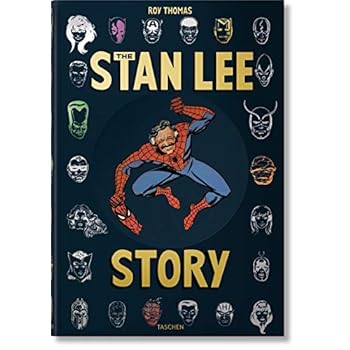The Stan Lee Story
Category: Books,Arts & Photography,Graphic Design
The Stan Lee Story Details
About the Author Since 1965, Roy Thomas has been writing for movies, television, and especially comic books. With notable runs on Avengers, Uncanny X-Men, Conan the Barbarian, The Incredible Hulk, and Star Wars, he served as a Marvel editor from 1965–80 and editor-in-chief from 1972–74. He currently edits the comics-history magazine Alter Ego and writes two online Tarzan strips as well as the occasional comic book. He and his wife Dann live in South Carolina.Stan Lee (1922–2018) is known to millions as the man whose super heroes propelled Marvel to its preeminent position in the comic book industry. His co-creations include Spider-Man, The Incredible Hulk, X-Men, The Fantastic Four, Iron Man, and hundreds of others. As the Chairman Emeritus of Marvel, he was also the Chief Creative Officer of POW! Entertainment, where he created numerous new characters and stories in areas including publishing, film, TV reality, stage, documentary, and multimedia. Read more

Reviews
It took me weeks to read this book, partly because I could not find a comfortable position in which to read it. The book is of extremely large dimensions and very heavy. Personally. I would have been satisfied with a normal-sized book, with the glossy paper retained. In any event, some of the reprinted comics at the back do not benefit from being magnified so much.As for the account of Lee's career--Roy Thomas was bound to write a well-informed account, and he does. Those hoping for a deeply detailed analysis of Lee's activities and public statements will be disappointed--it is breezier than that. Thomas is, however, a very good writer. (Though, Mr. Thomas, "given" means something taken as given; it does not mean "because of"--so you should not use it to mean that, as you do for example on page 361. Also, please avoid pop-economics of the kind that makes you assert on page 25 that the 1937 U.S. economic downturn came from a stock market crash.) Thomas covers the pre-1990 period well.Incidentally, Stan Lee is referred to as alive throughout the main text, so not much updating of the book has occurred.I didn't care for the way Lee's contributions to comics in the 1990s onward were taken as the product of a fertile imagination and a large supply of energy. The fact is that Lee essentially left comics writing in 1972 and the management of comics in 1980, and the upsurge in the number of products bearing his name in the 1990s, 2000s, and 2010s has a "Weekend At Bernie's" feel to it, because of the clear amount of hand-holding and ghosting involved. His contributions after 1980 in the form of interviews, convention appearances, bullpen/soapbox writings, and prose introductions to comics collections are far more clearly authentic transmissions of Lee's voice and thoughts than are the miscellany of fiction products (comics, television programs, and novels) over the same period (especially from 1990 onward) for which he was a, or the, titular writer.Other than the coverage of post-1990 events, the book's most glaring example of giving a rose-colored retrospective on events is the statement on page 295 that Thomas was "almost ecstatic" to be continuing to work with Lee at Marvel after Thomas shed the Editor-in-Chief position at 1974. Here are instead Roy Thomas' words closer to the time: "Stan and I came to our first parting of the ways back in 1974. It is true, though, that since then I've never felt the same about him and Marvel." (The Comic Reader, July 1980, p. 10.)Thomas mostly stays out (this time) of the debate on who created the Marvel Universe or should be credited as having primarily originated the 1960s Marvel comics output, though he does say in one passage that Lee's contribution was the biggest.I found one typo: On page 358, "do down" should just be "down."Here are some instances in which I believe there are factual errors or unnecessary imprecision:1. On page 318, Lee's move to California is said to be "some time in 1980." No need to be as imprecise as that. The public record seems to validate Raphael and Spurgeon's book dating it to by (end-) April 1980.2. On page 321, we are told of Lee's frustration at seeing Superman II rack up big box office numbers in 1980. Actually, the U.K. and U.S. releases of that film were not until 1981; its 1980 release was limited to peripheral markets (and then only in the closing weeks of 1980).3. The narrative takes until summer 1988 (p. 338) to give Lee as having the title of vice president of creative affairs, but Lee had held that position at Marvel (along with publisher) since 1980 (source: Bullpen Bulletins, November and December 1982).4. Page 337 could be read as implying that Steve Ditko didn't work for Marvel between the 1960s and 1987, when in fact he worked regularly for Marvel also in 1978-1985.5. Page 337 also gives the Silver Surfer: Judgment Day graphic novel as coming out in 1990. The correct date is 1988.6. Page 345 has a big error, saying that Lee's receiving the position of Marvel chairman in 1990 made his title of publisher now a former position. Actually, Lee's title of publisher (largely a courtesy, yes, but a compensated and official position) continued over the 1990s (for example, the indicia of Marvel's Star Trek: Untold Voyages #5 (July, 1998) says "Stan Lee, Publisher").








